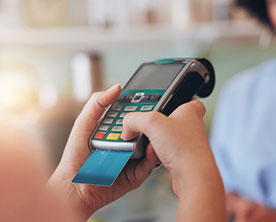Myanmar has changed a lot since becoming an attractive investment destination. Many businesses are always trying to modernize their products and services to cope with international businesses. Due to updated information technology, local people can easily recognize the success story and the benefits of using sophisticated products and services of developed countries. Their positive attitudes on digital products has dramatically increased. In today’s fast paced life, people are willing to change most of their daily usages especially payment methods into digital in order to save scare resources, especially time. Businesses also recognize the importance of digital transformation for their own success. Variety of digital payment methods comes with a growing middle class and the rapid growth of smart phones usage and penetration. However, people’s understanding of these methods does not grow. Businesses that launch digital products and services need to educate the methods of using them to the customers effectively. Many are ready to move on from cash because of the following benefits of using digital payment methods. According to the study by Moody’s Analytics, electronic payments benefit both consumers and businesses at a micro level.
Customers have secure and immediate access to all their funds on deposit or to a line of credit.
- • Access to credit eliminates the need to wait for a payday or having to save up to be able to buy expensive items.
- • It enables consumers to participate in the digital economy, expanding their choices immensely. • There is the convenience and security that electronic payments have over cash.
- • All of these also benefit merchants due to the increased and more uniform spending. Electronic payments also reduce businesses’ costs due to less cash and check handling costs and by enable selfservice options. Finally, they have access to a large pool of customers with guaranteed payments. At the macro level, the availability of electronic payments increased consumption and production, which in turn leads to more jobs, higher incomes and ultimately, greater economic growth.
- • Every one percent increase in card usage produces an average annual increase of over 0.04 percent in GDP across the markets studied. The impact on GDP is higher in developed countries than for developing countries, as card penetration is nearly three times higher in developed countries.
- • Electronic payments have the added benefits of reducing central bank costs in providing currency and eliminates a substantial portion of the gray economy, leading to greater tax revenues.
According to Visa’s Financial Education for Sustainable Growth Study, current ownership of payment cards in Myanmar is at 2 percent of total 1,044 respondents. However, 11 percent plan to get a card in the next 12 months. Twothirds of them said the key motivators to get a payment card are to be updated with modern digital landscape and the perception that it is a simpler method of payment. Half of them said it is safer to carry cards than large amounts of cash, especially when going shopping. The rest of them responded the benefits of using cards such as never being broke and being part of the increasing number of people who have a card now.
On the other hand, respondents who do not have plan to get a card said that they do not know enough about how cards work, do not have bank account, cards are not currently accepted at most traditional stores, concern that the card may not work due to unknown errors or the card may be used by others without their knowledge, as reasons for their preference for cash.
The cost of accepting cash for retailers can be as high as 5.8 percent of total sales. Wide adoption of electronic payment has economically proven to add to the country’s GDP. Very few respondents have ever tried going cashless, not surprising in a cashdominant market. However, 25 percent of respondents say they could survive for more than a month without cash. Despite the heavy reliance on cash, almost all believe a cashless society is possible. 29 percent said a cashless society may be possible in three years and 50 percent answered that it might happen within four to seven years. Contactless payments are payments made by tapping the card or phone to the electronic point of sales terminal, instead of swiping or inserting the cards. So far, 50 percent of respondents indicated that they would like to use it. With a growing interest of customers to use digital payment methods, businesses, particularly shopping centers need to modernize their payment systems for customers to fulfill local and international customers’ needs and wants, to save time and human resources and to be of international standards. Private and public authorities should promote the positive attitudes of customers on card systems before taking into actions. According to Moody’s Analytics study, trust in electronic payments is a key factor, for example, customers have recourse for fraudulent transactions. Reliability and accessibility of systems when needed is also important.
“While consumers are eager to try and adopt new form of payments, it is equally important to elevate financial literacy. After all, equipping consumers with an understanding of how modern payment methods work is a fundamental pre-requisite for sustainable economic growth and for Myanmar to fully reap the benefits of a digital economy,” said Arturo Planell, Visa Myanmar’s country manager.
Visa recently announced a significant milestone in the growth of contactless payments in Myanmar; 20 percent of all face-to-face Visa transactions now being contactless on September 18. Arturo said it will pave the way for the introduction and usage of other contactless payment methods such as wearable devices and mobile payments.
At the merchant’s side, City Mart Holding, leading supermarket in retail sector, launched City Rewards on September 21 to upgrade digital payments. City Rewards is the first system in retail sector which gives shopping and payment solutions. This will provide new, creative and easily accessible shopping experiences, reward points to customers and cashless payment methods. City Rewards are available in two types of methods: mobile application and card. A large amount of customers and merchants have to realize and accept the digital payment systems in order to get into the growth stage of digital payments in Myanmar.










